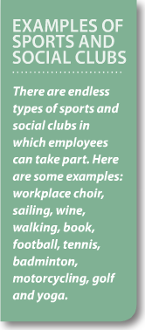If you read nothing else, read this…
- Sports and social clubs help build employee engagement and motivation.
- Clubs can help employers support employees’ emotional and physical wellbeing.
- Clubs are typically created and run by employees, but often funded by employers.
Clubs are typically initiated and run by employees, but they are owned and often funded by employers. Their focus varies greatly between employers, from social clubs including choirs to sports clubs offering netball, badminton and even white water rafting (see John Lewis case study). And there are many providers on hand to support employees’ chosen pursuits.
Music in Offices, for example, provides tutors for workplace choirs, as well as instrumental tuition for employees. Tessa Marchington, founder and director, says: “Sports clubs have, for years, been part of company culture, but now [employers] are recognising that playing for the rugby team doesn’t appeal to everyone. By offering a musical outlet, [employers] are giving employees a wider choice.”
Work-life balance
A great appeal of workplace clubs is that they give staff the opportunity to take part in activities they might not otherwise have considered, or have found the time to take up.
Ben Willmott, head of public policy at the Chartered Institute of Personnel and Development, says: “One of the challenges that a lot of [employees] have, particularly if they are working long hours or have a long commute, is to find ways to balance their work and non-work life. So these types of activities can enable people to, for example, find time to exercise, either at lunch or after work with colleagues who are into the same sports or activities.”
Marchington adds: “It is really important to offer [employees] activities during the working week as a stress release, and also for them to have access to creativity and ways of unwinding. Employees are often expected to work outside of office hours and are on call on email and Skype, blurring the divide between work life and home life. If they can fit their hobby into the working week, it leaves more time for family or friends at the weekend.”
Engage and motivate

Employers that are apprehensive about the potential impact of social activities on employees’ timekeeping and productivity should consider the fact that sports and social clubs can be used to foster employer-employee relationships.
For example, employers can demonstrate support for employees, and consequently engage them, by providing the facilities they require for their clubs, as well as by developing a communications strategy to promote the clubs throughout the organisation.
Clubs can also be an effective motivational tool. As well as reducing employees’ stress levels and boosting their overall health and wellbeing, club membership gives staff an opportunity to interact with their peers and feel a valued member of a supportive organisation. It also gives them an extra reason to go in to work, reducing employee absence levels.
Willmott adds: “From an engagement perspective, [clubs can give] the feeling that an employer is interested in an employee’s wellbeing, not just interested in them as a machine that comes to work and goes home again; it is interested in the employee as a whole.
“Ultimately, the interest, enthusiasm and engagement has to come from the workforce. But I think HR can play a role in supporting and occasionally nudging [employees] to decide to run these things.”
Duty of care
Employers have a duty of care to ensure staff carry out any necessary risk assessments when setting up a new club and embarking on any associated activities. Clubs at the John Lewis Partnership, for example, are run by staff volunteers who are clear about the rules (see case study).
Daniel Barnard, benefits analyst at the John Lewis Partnership, says: “We actually make the volunteers work quite hard to ensure that if they’re going abroad, or even for anything in the UK, that they have done the necessary risk assessments, spoken to the right people and that there is a level of insurance and cover.”
But employers are advised to pilot any club ideas before they or their employees implement them, to ensure there is sufficient interest among staff to support the initiative. Jake Outram, senior consultant at Aon Hewitt, says: “Each organisation needs to understand what is critical for its employees, either en masse or for key populations.”
The preparation involved in creating and implementing a club should not deter employers from supporting staff in their endeavours, in view of the long-term benefits clubs can offer an organisation.
Music in Offices’ Marchington explains: “I think it makes the employee feel happier about working for the [organisation] and therefore more productive.”

Viewpoint: Stephen Menko: A happy workforce is a productive workforce
The old adage that a happy workforce is a productive one is a business philosophy that still rings true today, perhaps more than ever. At a time when employees are often faced with increasingly tight deadlines and managers are tasked with getting more from limited budgets or personnel, every aspect of working practice is being evaluated by HR professionals to see what might yield better results.
There is certainly a changing perception among HR professionals about how this can be achieved.
A piece of research we published in June 2013 into how to boost productivity found that 52% of HR professionals felt that allowing employees to take gym or exercise breaks during work hours, along with providing healthy food, could make for happier, healthier and ultimately more productive employees.
As much as sport, exercise and other social activities are about improving the satisfaction and general happiness of individual employees, they are also about fostering teamwork. At its best, sport is one of the most unifying activities there is; you only have to witness a stadium full of people joining together to cheer on their team to experience it.
Similarly, sport and other social activities can be used to cultivate a sense of camaraderie and team spirit, which can be brought back to the workplace, helping to boost morale, productivity and results.
Stephen Menko is a director of HR recruiter Ortus

Case study: John Lewis Partnership offers employees sports and social activities
The John Lewis Partnership has operated a number of sports and social clubs for many years; in fact, they date back to its founder, who wanted to give employees, or partners as they are known, an opportunity they would not otherwise have had.
And so a sailing club was set up to enable the average employee to sail a boat.
The sailing club still operates today and is the most popular club offered by the retailer. The partnership owns its own yachts and pays for their upkeep, an investment the organisation has made as part of its total reward proposition.
Rachael Abbott, reward manager for benefits, says: “This is just one part of our total reward proposition; the reason people want to work for the partnership, and when they join, tend to stay for a long time, is because of their total reward package.”
The John Lewis Partnership currently runs 23 clubs, including a music, clay pigeon, drama, surfing, running, golf, garden and the venture club, which runs activities such as cycling in the Pyrenees, white water rafting and open water swimming.
The clubs are run by employee volunteers, but are subsidised by the organisation, with employees contributing, depending on the costs involved. To set up a club, at least three employees must be involved: a chairman, a treasurer and a secretary.
Just over 5,000 John Lewis employees have joined an average of three clubs each. After the sailing club, the wine club is the next most popular group, followed by the venture club.
Although the clubs are run by staff, the organisation sets out clear criteria and rules about how they should operate. For example, ahead of the motorcycle club visiting Spain for a two-day off-roading event, risk assessments are carried out to ensure employees have the appropriate insurance, and that the travel agents used are Abta-protected.
“Clubs and societies are one part of our total reward proposition, but they are an important part of that,” says Abbott. “This is about partners doing what they really enjoy and love.”
















